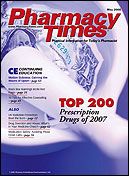Publication
Article
Pharmacy Times
Editor's Note: Ensuring the Integrity of Purchased Pharmaceuticals
Author(s):
Many recent news items have raised questions regarding the quality of the pharmaceutical supply; solving this will be a challenge, but suggestions are presented here.
Mr. McAllister is a health-systems consultant based in Chapel Hill, North Carolina.

Questioning the quality of purchasedpharmaceuticals is nota new issue. Many years ago,the proliferation of generic manufacturersresulted in the distribution of genericdrugs that were not bioequivalentto the market standard. Efforts such asregulatory reform by the FDA, educatingpharmacists in assessing bioequivalencebefore making source selections,buyers switching sources to ensurequality, and generic industry self-reformimproved the quality and reliability ofdrug supplies.
More recently, the integrity of thedrug supply was compromised when intermediariesin the ?grey market? adulteratedhigh-cost injectables by dilutionto reap huge profits. This was followedby the proliferation of counterfeit oraland injectable drugs of questionablequality that became available via theInternet, often from foreign sources.Purchasers became more savvy, andpressure was brought to bear on wholesalersand distributorsto ensure thequality of their sources of drugs.
Pharmacists, professional associations,the FDA, and manufacturers collaboratedto promulgate requirementsfor radio frequency identification (RFID)technology to help ensure the qualityof selected drugs while they are in thesupply chain pipeline. I suspect thatthese measures have helped ensurethe quality of selected drugs, but widespreadapplication of RFID technologyhas not yet been realized. Many stateboards of pharmacy have respondedto this issue with a variety of strategiesto minimize if not eliminatecounterfeit and adulterateddrugs. The California Boardof Pharmacy enacted veryaggressive requirementsto combat this issue butrecentlyannounced a second2-year delay in requiringcompliance for a varietyof reasons, predominantlybecause manufacturers anddistributors claim that completecompliance is currentlyunrealistic.
Over the past severalmonths, the quality of injectableheparin has come underscrutiny, with over a dozendeaths being attributed toadulterated product manufacturedin China. Nationwide recallshave resulted, and the availability of heparininjection has been compromised. Arecent article in the New York Times(March 30, 2008) released a shockingexpos? on this topic, including a picturethat sent shivers up my spine. I realizedthat it is possible that other drugs manufacturedoutside the United Statesare similarly compromised in terms ofquality. It is interesting, however, thatHospira avoided recall of its heparinproducts; although the company obtainedproduct from the same supplierthat made the recalled heparin and producedother products using raw materialsfrom China, the company requestedproduct that was produced using rawmaterials from only the United Statesand Canada.
Solving this dilemma will be challenging.Collaboration of pharmacists,manufacturers, wholesalers, and distributors,as well as regulatory agenciesat the state and national level, shouldbegin expeditiously. As reformers considerstrategies to ensure quality andintegrity, I suggest that the followingbe considered:
- Manufacturers should bear all costsof the recall to hospitals and pharmaciesby an established formula
- The FDA should create and maintaina comprehensive and readilyaccessible list of recalls for thosemaking source selection decisions
- Manufacturers, rather than the FDA,should be held financially accountablefor the quality and integrity ofdrugs or chemicals used to manufactureits drugs not produced inthe United States
- The FDA should be empowered tolevy substantial economic sanctionsfor substandard drugs sold
In the interim, decision makers inpharmacy should use all their expertiseand experience in source selection ofthe drugs they buy and, to the extentpossible, hold manufacturers and distributorsaccountable for drug qualityin every way possible.







